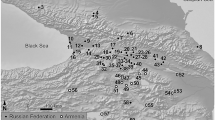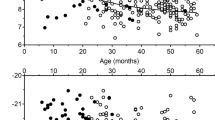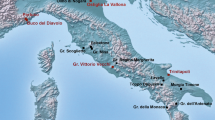Abstract
High δ13C in human tissues in Brazil indicate high consumption of C4-based sources due to the consumption of highly processed food and animal protein. The significant positive correlation between the human developed index (HDI) developed by the United Nations Development Program, and fingernail δ13C at the county level proved to be useful as a new proxy in tracking human nutrition. Regions with higher HDI are those with higher consumption of highly processed food.
Similar content being viewed by others
Introduction
Several studies have used the multi-isotope approach to track the geographic origin of human remains as well as human movement in forensic anthropology1, but only a few studies have used it in association with socioeconomic status and dietary behavior changes2. These studies have demonstrated the progressive substitution of local food staples by industrialized processed foods in the developing regions of the world (the so-called nutrition transition process)3. In this context, we explored stable isotopic analysis as a new proxy for human nutrition status across Brazil under the worldwide “global supermarket” dietary trend. Brazil is a middle-income country with contrasting inequitable geographic regions in terms of socioeconomic development, health, and educational services4. We compared the carbon isotopic ratio of fingernails from residents of more economic developed regions of the country, where high consumption of processed food prevails, with the less developed regions, where locally produced food predominates, particularly staples like rice, beans, and cassava.
While C3 plants have δ13C varying approximately from −34 to −24‰, C4 plants have δ13C that varies from −14 to −10‰, with no overlap between these plant types5. Therefore, in recent decades, carbon isotopic composition became a useful tool to track C3 and C4 carbon in biological systems worldwide6. Despite the fact that pineapple that is a CAM plant that could confound a straightforward interpretation of C3 vs. C4 diet contribution5. its consumption has no significant impact in the Brazilian diet. In fact, fruits and vegetables provide approximately only 2% of total daily calories to Brazilians6.
Brazil is mostly a tropical country with proper climatic conditions to grow C4 crops; among them, C4 pastures cover an area of almost 200 million ha4. Although soy occupies almost 35 million ha, corn is the second arable crop in the country covering almost 20 million ha, and sugarcane covering 10 million ha is the third. Due to these vast productive areas, C4 carbon sources in Brazil are generally an inexpensive alternative for the food industry either as sugar or high-fructose corn syrup. Accordingly, C4 carbon is available in the country in several energy-dense processed foods like dairy, various types of processed meats, beverages (soft drinks, wine, and beer), cakes, crackers, and even unexpectedly, in products like soy sauce7,8.
This in part explains why Brazilians residing in urban areas have higher δ13C in human tissues than residents of other countries9,10. However, in more isolated towns and villages in different geographic regions of Brazil where the degree of market integration is highly variable, the δ13C of human tissues reflects a diet based more on C3 plants (rice, beans, cassava), coupled with consumption of locally derived animal protein, such as fish or bushmeat, depending on the region11.
Motivated by the fact that Vale et al.12 reported a positive correlation between Human Development Index (HDI) and body weight at the state level in Brazil, our initial hypothesis was that at the county level, the HDI and fingernail δ13C representing county residents [δ13C]m would be positively correlated. In order to test this hypothesis, we correlated the HDI at the county level [HDI]m with the [δ13C]m (see “Methods” for definition) among 37 counties distributed in different geographic regions of Brazil (Fig. S1—Supplementary material).
Results and discussion
We found a strong positive sigmoidal correlation (Fig. 1) between these two parameters according to the Boltzmann’s equation (R2Adj. = 0.72, Reduced χ2 = 1.55 by Levemberg–Marquadt algorithm):
In this sense, Eq. (1) suggests higher consumption of processed food in areas with higher HDI, where market integration and purchasing power are higher than less developed areas of the country. This finding is in line with Vale et al.12, confirming our initial hypothesis.
Using the Eq. (1), the [δ13C]m was estimated for the 5507 Brazilian counties (see “Methods”), and with these values a map of [δ13C]m was generated in order to shed light on spatial trends for the country (Fig. 2). Although we found a robust correlation, future investigations on fingernails δ13C in municipalities with contrasting [HDI]m and in different regions of Brazil should be conducted to validate our model. We see a clear spatial polarization between north and south with lower [δ13C]m values in the north than in the south, which means that in the north, C3-like foods predominate in the diet, resembling Brazilian staple foods, while in the south, C4-like foods predominate, which represents a higher market integration and consumption of processed food (Fig. 2).
Values of the average δ13C for each municipality ([δ13C]m) obtained through the correlation average δ13C of fingernails and [HDI]m of 37 Brazilian counties (Eq. (1)). Each dot represents one municipality of Brazil using municipality centroid geographic coordinates.
Therefore, if we accept that [δ13C]m is a proxy for higher consumption of processed food and adherence to the supermarket diet, it seems that in the southern region, the so-called nutrition transition has already been completed, whereas in the northern region this transition is still taking place (Fig. 2).
If the [HDI]m continues to grow, especially in counties of the northern states of the country, we will see an increase in [δ13C]m, indicating the late stage of the nutrition transition and a predominance of the supermarket diet with a high degree of market integration. Future trends of [δ13C]m in the southern states of the country are more difficult to predict, if this part of the country adopts a plant-based diet that includes lower consumption of meats coupled with higher consumption of whole grain cereals, legumes, and fruits, we predict a decrease in the [δ13C]m of this region in the future.
The discussion above acknowledges that our model has potentially a limited time span according to the progress of the socioeconomic conditions of the country as a whole and its different regions. Our model also has a geographic-limited scope being only potentially valid in those countries where there are inexpensive sources of C4 dietary carbon, which is the case in most northern-temperate countries.
However, we believe that in countries like Brazil, the [δ13C]m could be another tool for detecting macro-scale trends in nutrition in time and space, since as emphasized by Walls et al.13, it is not easy to evaluate nutrition trends in low and medium-income countries, and the isotopic approach shown here could be also useful in linking social-economic dimensions to dietary trends. In addition, it provides new perspectives in human forensic anthropology as a powerful tool for tracking human movement in the contemporary world under the “supermarket diet” trend.
Methods
The carbon isotope ratio (13C:12C) was determined in fingernails of residents of 37 Brazilian counties totaling almost 4500 samples (Supplementary Table 1; Supplementary Fig. 1). Briefly, fingernails were collected from donors using fingernail clippers. Samples were then cleaned with a solution of distilled water, methanol, and chloroform. For this survey, an authorization by the official Brazilian human ethical committee was previously submitted, approved, and received the registration number of COET 053, Piracicaba, São Paulo, Brazil.
The carbon isotopic ratio (13C:12C) in these samples was determined through a Delta Plus mass spectrometer for isotopic ratios (ThermoFisher Scientific), in the Laboratory of Isotope Ecology, CENA (University of São Paulo), Brazil. The results were reported as the deviation (δ) in parts per thousand (‰) relative to standard international references; δX = (Rsample/Rstd − 1) × 1000; where, X is carbon, R is the heavy to light isotope ratio for carbon (13C:12C) of the sample (Rsample), and of the standard (Rstd), VPDB-Vienna Pee Dee Belemnite. BBOT (Fisons Instruments [C26H26N2O2S]) and “grounded leaves of sugarcane” were used as internal standards to calibration during analysis runs. Every ten runs, both internal standards were used as target sample. Long-term standard deviations of internal standards used at the Ecology Isotope laboratory are of 0.2‰ for carbon.
The fingernail δ13C aggregated at the municipality level ([δ13C]m) was obtained by averaging the δ13C of all donors from a municipality.
The counties included in this study represent 0.7% of the 5,507 Brazilian counties, and ~10% of Brazil’s population (Supplementary Table 1). These counties were chosen due to opportunities created by several scientific projects that resulted in a series of publications9,7. Details on sampling can be found in these publications. Not all samples were obtained in the same year, and this fact could be a limitation resulting in biased findings if temporal changes were large. However, most of the samples (almost 70%) were obtained from 2008 to 2015; 23% from 2002 to 2006; and 10% after 2015. Another important source of variability could be the fact that in some regions only urban centers were sampled, whereas in others, mainly in the Amazon region, small isolated villages were also included. This is important to mention because we have shown in other publications that urban centers are fully market integrated, and more isolated villages are not; these villages tend to have lower δ13C than urban centers in the same county7.
The HDI was created in 1990 by the United Nations as a response to persistent criticism throughout the 1980s that economic development alone could not capture human development (http://hdr.undp.org/en/content/human-development-index-hdi). Brazil was the first country to launch HDI at the municipality level ([HDI]m) using basically the same parameters of the HDI developed by the United Nations. We obtained HDI at the municipality level [HDI]m for 2010, the last available year for Brazilian counties (http://www.atlasbrasil.org.br).
Optimal parameters of the Boltzmann’s sigmoidal model were obtained using a Levemberg–Marquadt algorithm of the Origin software (ver 8.6, Originlab). The Boltzmann sigmoidal equation used in the present work was:
where A1 and A2 are the equilibrium values of the dependent variable before and after the transition, respectively; x0 is the inflection point and ∂x is the slope of the curve that describes the behavior of the process during the transition. The fingernail δ13C values of each Brazilian municipality was obtained based on predictions of [δ13C]m from [ΗDΙ]m according to the above equation, using municipality centroid geographic coordinates.
High consumption of seafood, with δ13C values close to C4 crops, could show a false positive correlation between δ13C of human tissues and consumption of meats and processed food. However, due to its high price, seafood consumption in Brazil is rather low, even in coastal cities as well as in marine fishing villages.14
Data availability
The data used in this article is in the Table 1 of the Supplementary material.
References
O’Connell, T. C., Hedges, R. E. M., Healey, M. A. & Simpson, A. H. R. W. Isotopic comparison of hair, nail and bone: modern analyses. J. Archaeol. Sci. 28, 1247–1255 (2001).
Gragnani, J. G., Garavello, M. E. P. E., Silva, R. J., Nardoto, G. B. & Martinelli, L. A. Can stable isotope analysis reveal dietary differences among groups with distinct income levels in the city of Piracicaba (southeast region, Brazil)? J. Hum. Nutr. Diet. 27, 270–279 (2014).
Piperata, B. A., Spence, J. E., Da-Gloria, P. & Hubbe, M. The nutrition transition in amazonia: rapid economic change and its impact on growth and development in Ribeirinhos. Am. J. Phys. Anthropol. 146, 1–13 (2011).
Martinelli, L. A., Naylor, R., Vitousek, P. M. & Moutinho, P. Agriculture in Brazil: impacts, costs, and opportunities for a sustainable future. Curr. Opin. Environ. Sustain. 2, 431–438 (2010).
Farquhar, G. D., Ehleringer, J. R. & Rubick, K. Discrimination and photosynthesis. Annu. Rev. Plant Physiol. Mol. Biol. 40, 503–537 (1989).
Levy-Costa, R. B., Sichieri, R., Pontes, N. S. & Monteiro, C. A. Household food availability in Brazil: distribution and trends (1974-2003). Rev. Saúde. Pública 39, 530–540 (2005).
Nardoto, G. B. et al. Frozen chicken for wild fish: nutritional transition in the Brazilian Amazon region determined by carbon and nitrogen stable isotope ratios in fingernails. Am. J. Hum. Biol. 23, 642–650 (2011).
Brooks, J. R. et al. Heavy and light beer: a carbon isotope approach to detect C4 carbon in beers of different origins, styles, and prices. J. Agric. Food Chem. 50, 6413–6418 (2002).
Nardoto, G. B. et al. Geographical patterns of human diet derived from stable-isotope analysis of fingernails. Am. J. Phys. Anthropol. 131, 137–146 (2006).
Valenzuela, L. O., Chesson, L. A., O’Grady, S. P., Cerling, T. E. & Ehleringer, J. R. Spatial distributions of carbon, nitrogen and sulfur isotope ratios in human hair across the central United States. Rapid Commun. Mass Spectrom. 25, 861–868 (2011).
Silva, R., Garavello, M., Nardoto, G., Mazzi, E. & Martinelli, L. Factors influencing the food transition in riverine communities in the Brazilian Amazon. Environ. Dev. Sustain. 19, 1087–1102 (2017).
Vale, D. et al. Spatial correlation between excess weight, purchase of ultra-processed foods, and human development in Brazil. Ciênc. Saúde. Colet. 24, 983–996 (2019).
Walls, H. L., Johnston, D., Mazalale, J. & Chirwa, E. W. Why we are still failing to measure the nutrition transition. 2017–2019. https://doi.org/10.1136/bmjgh-2017-000657 (2018).
Hanazaki, N. & Begossi, A. Does fish still matter? Changes in the diet of two Brazilian fishing communities. Ecol. Food Nutr. 42, 279–301 (2010).
Acknowledgements
We would like to acknowledge the financial support through Fapesp grant: 2015/50345-9.
Author information
Authors and Affiliations
Contributions
L.A.M. and G.B.N. wrote the first paper, P.J.D.-N. and J.P.S.-S. performed all statistical and geo-spatial analysis, F.J.V.C., T.B.K., and J.E. contributed to the analysis and interpretation of the data, as well as in revising several versions of this paper.
Corresponding authors
Ethics declarations
Competing interests
The authors declare no competing interests.
Additional information
Publisher’s note Springer Nature remains neutral with regard to jurisdictional claims in published maps and institutional affiliations.
Supplementary information
Rights and permissions
Open Access This article is licensed under a Creative Commons Attribution 4.0 International License, which permits use, sharing, adaptation, distribution and reproduction in any medium or format, as long as you give appropriate credit to the original author(s) and the source, provide a link to the Creative Commons license, and indicate if changes were made. The images or other third party material in this article are included in the article’s Creative Commons license, unless indicated otherwise in a credit line to the material. If material is not included in the article’s Creative Commons license and your intended use is not permitted by statutory regulation or exceeds the permitted use, you will need to obtain permission directly from the copyright holder. To view a copy of this license, visit http://creativecommons.org/licenses/by/4.0/.
About this article
Cite this article
Nardoto, G.B., Sena-Souza, J.P., Kisaka, T.B. et al. Increased in carbon isotope ratios of Brazilian fingernails are correlated with increased in socioeconomic status. npj Sci Food 4, 9 (2020). https://doi.org/10.1038/s41538-020-0069-1
Received:
Accepted:
Published:
DOI: https://doi.org/10.1038/s41538-020-0069-1





